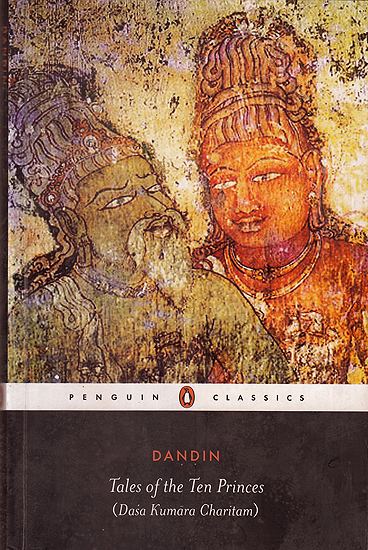Died India | ||
 | ||
Books Dashakumaracharita, Dandin's Dasha‑kumara‑charita, Tales of The Ten Princes, Kāvyādarśa, Kāvyādarśaḥ of Daṇḍin: Text with t Similar Bharavi, Kālidāsa, Bāṇabhaṭṭa, Bhavabhuti, Johannes Hertel | ||
Daṇḍin was a seventh- to eighth-century Sanskrit grammarian and author of prose romances, and 'is one of the best-known writers in all of Asian history'. A range of evidence points to an association with the Pallava dynasty and its court at Kanchipuram in modern-day Tamil Nadu. His writings were all in Sanskrit.
Contents
Biography
Daṇḍin's life and times have been studied particularly by D. K. Gupta. If we accept the account of Daṇḍin's life in his Avantisundarī as genuine autobiography, Daṇḍin was a great-grandson of one Dāmodara, a court poet from Vidarbha who served, amongst others, the Pallava king Siṃhaviṩṇu and King Durvinīta of the Western Ganga dynasty:
Dāmodara was married in Kāñcī and fathered three sons; his middle-born, Manoratha, had four sons; Manoratha’s youngest son, Vīradatta, married a Brahmin woman, Gaurī, and they had several daughters and, eventually, a son, Daṇḍin. Daṇḍin then reports that he lost his mother at the age of seven and his father shortly thereafter, and that as an orphan, he had to flee Kāñcī because of an enemy invasion and was able to return only once peace was restored.
Yigal Bronner concludes that 'These details all suggest that Daṇḍin’s active career took place around 680–720 CE under the auspices of Narasiṃhavarman II Rājasiṃha in Kāñcī (r. 690/1–728/9)'.
Daṇḍin was widely praised as a poet by pre-modern Sanskrit commentators such as Rājaśekhara (fl. 920 CE), and his works widely studied to this day. One shloka (hymn) that explains the strengths of different poets says: दण्डिन: पदलालित्यम् "daṇḍinaḥ padalālityaṃ" ("Daṇḍin is the master of playful words").
However, Daṇḍin's works are not well preserved. He composed the now incomplete prose Daśakumāracarita, and the even less complete Avantisundarī (The Story of the Beautiful Lady from Avanti), also in prose. But he is best known for composing the Kāvyādarśa ('Mirror of Poetry'), the handbook of classical Sanskrit poetics, or Kāvya, which seems to be preserved intact. There has been some debate over whether these were all composed by the same person, but 'there is now a wide consensus that a single Daṇḍin in authored all these works at the Pallava court in Kāñcī around the end of the seventh century'.
Kāvyādarśa
The Kāvyādarśa is the earliest surviving systematic treatment of poetics in Sanskrit. It has been shown that Kāvyādarśa was strongly influenced by the Bhaṭṭikāvya of Bhaṭṭi. In Kāvyādarśa, Daṇḍin argued that a poem's beauty derived from its use of rhetorical devices – of which he distinguished thirty-six types.
He is also known for his complex sentences and creation of very long compound words (some of his sentences ran for half a page, and some of his words for half a line).
The Kāvyādarśa has been widely recognised as similar to and in many ways in disagreement with the Kāvyālaṃkāra by Bhāmaha. Although modern scholars have debated which scholar was borrowing from which, or who was responding to whom, recent work suggests that Bhāmaha was the earlier scholar, and that Daṇḍin was responding to him. By the tenth century, the two works were apparently being studied as a pair, and seen as foundational works in scholarship on Sanskrit poetry.
Daśakumāracarita and Avantisundarī
The Daśakumāracarita, now incomplete, is a prose text relating the vicissitudes of ten princes in their pursuit of love and royal power. It contains stories of common life and reflects a faithful picture of Indian society during the period couched in the colourful style of Sanskrit prose. It consists of (1) Pūrvapīṭhikā, (2) Daśakumāracarita Proper, and (3) Uttarapīṭhikā.
Overlapping in content with the Daśakumāracarita and also attributed to Daṇḍin is the even more fragmentary Avantisundarī or Avantisundarīkathā (The Story of the Beautiful Lady from Avanti), also in prose. The story told by its two fragmentary manuscripts is eked out by a later, fragmentary Sanskrit poem, the Avantisundarīkathāsāra (Gist of the Story of the Beautiful Lady from Avanti) and a fragmentary a thirteenth-century Telugu translation.
The two texts might represent separate compositions on the same theme by the same author, or parts of one prose work by Daṇḍin that was broken up early in its transmission.
Books
Adventures of the Ten Princes (Dasha-Kumara-Charita) - Translated by Arthur W. Ryder in 1927
Mirror of Poetry
